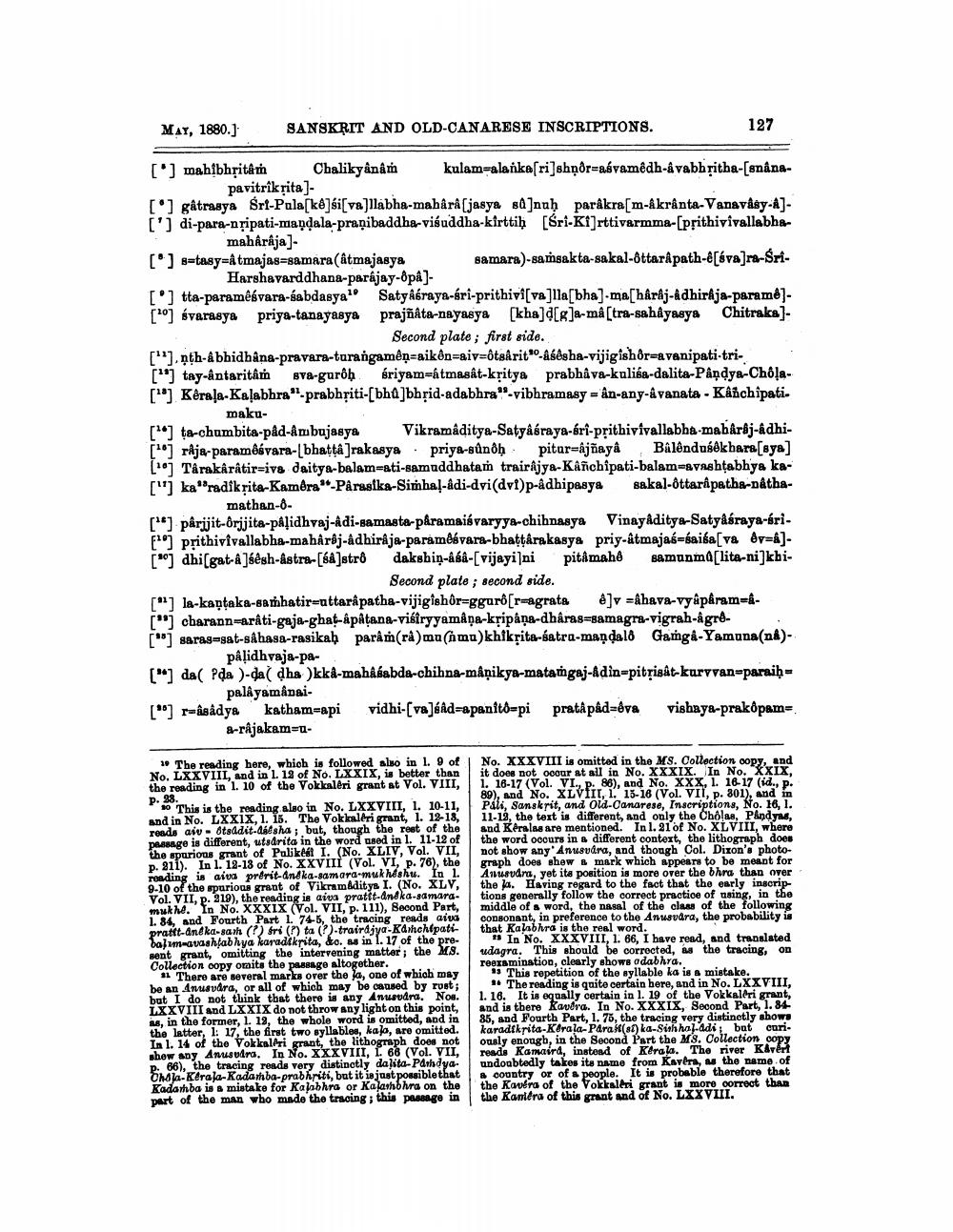________________
MAY, 1880.]
SANSKRIT AND OLD-CANARESE INSCRIPTIONS.
127
['] mahibhřitâm Chalikyanan kulam-alankasri]shạðr=asvamêdh-&vabh sitha-[snana
pavitrik rita)[°] gâtrasya Śrf-Pala[k]śi[va]llabha-maharajasya sa]nuḥ paråkra[m-Akranta-Vanavåsy-A)[') di-para-nțipati-mandala-pranibaddha-visuddha-kirttih [Ári-Ki]rttivarmma-sprithivivallabha
mahârâja)[] stasy=&tmajas=samara (âtmajasya samara)-samsakta-sakal-6ttarApath-@[áva]ra-Sri
Harshavarddhana-parajay-8på). ['] tta-paramêsvara-sabdasya Saty Aśraya-sri-prithivi va]lla[bha].ma[haraj-Adhiraja-parame)[] śvarasya priya-tanayasya prajñâta-nayasya [kha]d[8]a-má (tra-sahayasya Chitraka)
Second plate; first side. [""], ņth-Abhidhâna-pravara-turangamêņ=aikôn=aiv=ôtsÂrit"-Abêsha-vijigish&r=avanipati-tri["'] tay-antaritam sva-gurôḥ śriyam-ktmasât-kritya prabhava-kulisa-dalita-Pandya-Chôļa[*] Kéraļa-Kalabhra"-prabhpiti-[bh@]bhřid-adabhra"-vibhramasy = án-any-Avanata - Kaichỉpati.
maku["] ta-chumbita-pâd-Ambujasya Vikramaditya-Satyâśraya-sri-prithivivallabha-mahároj-adhi[""] râja-paramêsvara-[bhattâ ]rakasya . priya-sûnôh pitur=ajñayâ Balêndusêkhara[sya) [*] Târakârâtir=iva daitya-balam=ati-samuddhatam trairajya-Kâfchipati-balam=&vashtabhya ka["] ka "radikrita-Kambra"-Pârasika-Simhal-adi-dvi(dvt)p-adhipasya sakal-Ottaripaths-natha
mathan-8[") pârijit-ôrjjita-pálidhvaj-Adi-samaste-pâramaišvaryya-chihnasya Vinayaditya-Satyasraya-bri. F) prithivivallabha-maharaj-adhiraja-paraméévara-bhattárakasya priy-âtmajas=saiba [va év=a)[") dhi[gat-a]śêsh-astra- [sk]strô dakshin-âsa-[vijayi ni pitâmahê samunma[lita-ni]khi
Second plate ; second side. ["] la-kaộtaka-samhatir-attarapatha-vijigishor=ggurð[ræagrata é]v =&hava-vyâpâram=d[") cbarann-arâti-gaja-ghat-Apåtana-vibiryyamåņa-kripaņa-dháras=samagra-vigrah-agro[*] sarag=gat-sahasa-rasikab parâm(ra)mu(imo)khikrita-atra-mandald Ganga-Yamuna(na)
pâlidhvaja-pa["] da( pda )-dal dha )kka-mahababda-chihna-måņikya-matagaj-Adin-pitrisât-karyvan-paraiḥ=
palayamanai. [") r-âsadya katham-api vidhi-[vajúkd=apanitd-pi pratâ påd=&va vishaya-prakópam
&-råjakam=n
* The reading here, which is followed also in l. 9 of No. LXXVIIL and in L. 12 of No. LXXIX, is better than the reading in l. 10 of the Vokkalēri grant at Vol. VIII, p. 93.
10 This is the reading also in No. LXXVIII, 1. 10-11, and in No. Lxxix, 1. 15. The Vokkalëri grant, 1. 12-18, reads aiv - Otaddit-dassha; but, though the rest of the passage is different, utsdrita in the word used in l. 11-12 of the spurions grant of Palikel I. (No. XLIV, Vol. VII, p. 211). In l. 18-18 of No. XXVIII (Vol. VI, p. 76), the ronding in aius prérit-andka-samara-wuk Mahu. In l. 9-10 of the spurious grant of Vikramaditys I. (No. XLV, Vol. VII, p. 319), the reading is aina pratit-andka-samara. makne. In No. XXXIX (Vol. VII, p. 111), Second Part, 1. 84, and Fourth Part 1 74-5, the tracing_reads aiva pratit-aneka-sarh (?) fri () ta (?)trairdjya-Kdyhchépatibalum avashfabhya karadikrita, do. as in 1. 17 of the pregent grant, omitting the intervening matter; the MS. Collection copy omits the passage altogether.. .
11 There are several marks over the la, one of which may be an Anusvdra, or all of which may be caused by rust; bat I do not think that there is any Anusudra. Nos. LXXVIII and LXXIX do not throwany light on this point, is, in the former, 1. 13, the whole word is omitted, and in the latter, 1: 17, the first two syllables, kalo, are omitted. In 1. 14 of the Yokkaldri grant, the lithograph does not show any Anusudra. In No. XXXVIII, 1. 68 (Vol. VII, P. 86), the tracing reads very distinctly dalita-Pathdya. Ohola-Kerala-Kadamba-prabhriti, but it is just possible that Kadamba is a mistake for Kalabhra or Kalabhra on the part of the man who made the tracing; this passage in
No. XXXVIII is omitted in the MS. Collection copy, and it does not occur at all in No. XXXIX. In No. XXIX. l. 16-17 (Vol. VI., P. 88), and No. XXX, L. 16-17 (id... 89), and No. XLVIII, 1. 13-16 (Vol. VII, p. 301), and in Pili, Sanskrit, and Ola-Canarese, Inscriptions, No. 16, 1. 11-13, the text is different, and only the Cholas, Pandyas, and Keralas are mentioned. In 1.21 of No. XLVIII, where the word occurs in a different context, the lithograph does not show any. Amusvara, and though Col. Dixon's photograph does shew & mark which appears to be meant for Amun, yet its position is more over the bhra than over the 14. Having regard to the fact that the early inscrip tions generally follow the correct practice of using, in the middle of a word, the nasal of the class of the following consonant, in preference to the Ansudra, the probability is that Kalabhra is the real word.
15 In No. XXXVIII, 1. 66, I have read, and translated udagra. This should be corrected, as the tracing, on reexamination, clearly shows adabhra.
15 This repetition of the syllable ka is a mistake.
"The reading is quite certain here, and in No. LXXVIII, 1. 16. It is equally certain in l. 19 of the Vokkalëri grant, and is there Kavera. In No. XXXIX, Second Part, 1.84 85, and Fourth Part, 1. 75, the tracing very distinctly shows karadfkrita-Kerala-Paral(81) ka-Sithhol-adi bat curiously enough, in the Second Part the MS. Collection copy reads Kamard, instead of Kerala. The river Kavert undoubtedly takes its name from Kavēra, the name of
country or of people. It is probable therefore that the Kavera of the Vokksleri grant is more correct than the Kaniera of this grant and of No. LXXVIII.




